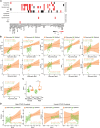Kynurenic acid may underlie sex-specific immune responses to COVID-19
- PMID: 34230210
- PMCID: PMC8432948
- DOI: 10.1126/scisignal.abf8483
Kynurenic acid may underlie sex-specific immune responses to COVID-19
Abstract
Coronavirus disease 2019 (COVID-19) has poorer clinical outcomes in males than in females, and immune responses underlie these sex-related differences. Because immune responses are, in part, regulated by metabolites, we examined the serum metabolomes of COVID-19 patients. In male patients, kynurenic acid (KA) and a high KA-to-kynurenine (K) ratio (KA:K) positively correlated with age and with inflammatory cytokines and chemokines and negatively correlated with T cell responses. Males that clinically deteriorated had a higher KA:K than those that stabilized. KA inhibits glutamate release, and glutamate abundance was lower in patients that clinically deteriorated and correlated with immune responses. Analysis of data from the Genotype-Tissue Expression (GTEx) project revealed that the expression of the gene encoding the enzyme that produces KA, kynurenine aminotransferase, correlated with cytokine abundance and activation of immune responses in older males. This study reveals that KA has a sex-specific link to immune responses and clinical outcomes in COVID-19, suggesting a positive feedback between metabolites and immune responses in males.
Copyright © 2021 The Authors, some rights reserved; exclusive licensee American Association for the Advancement of Science. No claim to original U.S. Government Works. Distributed under a Creative Commons Attribution License 4.0 (CC BY).
Figures



Update of
-
Kynurenic acid underlies sex-specific immune responses to COVID-19.medRxiv [Preprint]. 2020 Sep 8:2020.09.06.20189159. doi: 10.1101/2020.09.06.20189159. medRxiv. 2020. Update in: Sci Signal. 2021 Jul 06;14(690):eabf8483. doi: 10.1126/scisignal.abf8483. PMID: 32935119 Free PMC article. Updated. Preprint.
References
-
- Takahashi T., Ellingson M. K., Wong P., Israelow B., Lucas C., Klein J., Silva J., Mao T., Oh J. E., Tokuyama M., Lu P., Venkataraman A., Park A., Liu F., Meir A., Sun J., Wang E. Y., Casanovas-Massana A., Wyllie A. L., Vogels C. B. F., Earnest R., Lapidus S., Ott I. M., Moore A. J., Yale I. R. T., Shaw A., Fournier J. B., Odio C. D., Farhadian S., Dela Cruz C., Grubaugh N. D., Schulz W. L., Ring A. M., Ko A. I., Omer S. B., Iwasaki A., Sex differences in immune responses that underlie COVID-19 disease outcomes. Nature 588, 315–320 (2020). - PMC - PubMed
-
- Song J.-W., Lam S. M., Fan X., Cao W. J., Wang S. Y., Tian H., Chua G. H., Zhang C., Meng F. P., Xu Z., Fu J. L., Huang L., Xia P., Yang T., Zhang S., Li B., Jiang T. J., Wang R., Wang Z., Shi M., Zhang J. Y., Wang F. S., Shui G., Omics-driven systems interrogation of metabolic dysregulation in COVID-19 pathogenesis. Cell Metab. 32, 188–202.e5 (2020). - PMC - PubMed
Publication types
MeSH terms
Substances
Grants and funding
LinkOut - more resources
Full Text Sources
Medical

